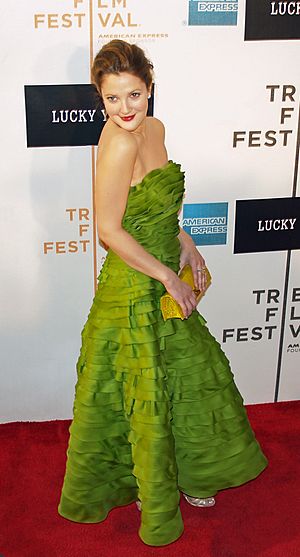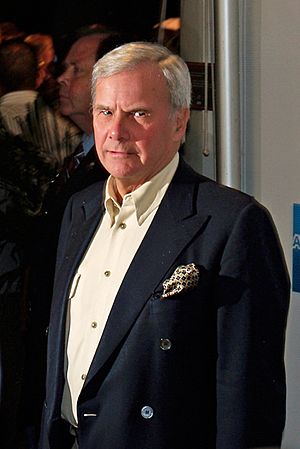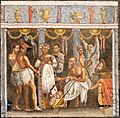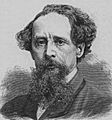Celebrity facts for kids

A celebrity is a person who is very famous and gets a lot of attention from the public and the media. The word comes from the Latin word celeber, which means famous. Someone can be famous, but not everyone famous is a celebrity. People become celebrities when the public is really interested in them. This interest might be because of what they do, like acting or playing sports.
Some celebrities are famous for a short time, perhaps after being on a TV show or doing something exciting, like rowing across the Atlantic Ocean. There are also special celebrities who are only famous within a certain group of people who share a hobby or interest.
A public figure, like a politician or a business leader, might be famous. But they usually become a celebrity only when the public and mass media become very interested in them. For example, Richard Branson, who leads Virgin Group, was famous as a business CEO. But he became a global celebrity when he tried to fly around the Earth in a hot air balloon. On the other hand, people in entertainment, like soap opera actors or music stars, often become celebrities even if they try to avoid media attention.
A famous idea about celebrities comes from Daniel J. Boorstin. He said that celebrities are people who are well known just for being "well-known."
Contents
Global Celebrities
A few celebrities are known all over the world. Their fame has spread across English-speaking countries and even into other cultures. These global celebrities are often important politicians, Hollywood actors, very successful pop musicians, and sports stars.
Some examples of internationally known celebrities include:
- Politicians like Nelson Mandela
- Actors like Tom Cruise, Will Smith, Drew Barrymore, Meryl Streep, and Emma Watson
- Pop singers like Michael Jackson and Madonna
- Sports stars like David Beckham and Tiger Woods
The rise of global celebrities in acting and music is largely because of the huge size of the US media industry. US companies have a big influence on film, TV, and music around the world.
Celebrities in Different Regions
Each country has its own system for celebrities. This includes popular film, TV, and sports stars. A celebrity who is very popular in one country, like India, might not be known in other countries. They might only be known by people from that culture living abroad.
Sometimes, a country's celebrity might get some attention outside their home country. But they might not be famous enough to be called a global celebrity. For example, the singer Lara Fabian is very well-known in French-speaking places. But she only had a few hits in the U.S. In contrast, Celine Dion is famous in both French and English-speaking communities.
Smaller areas or cultural groups also have their own celebrities. This is common in places with different languages or cultures, like Quebec (a French-speaking part of Canada) or Puerto Rico (a Spanish-speaking US territory). Local news reporters, politicians, or community leaders can be regional celebrities. For instance, a TV reporter might be famous in Arizona but not known much outside that area.
In smaller countries or cultural groups, it can be harder to become a global celebrity. Shakira and Daddy Yankee were mostly known in the Spanish-speaking world. They became popular in English-speaking communities after they started performing English language songs. Similarly, Spanish actors Penélope Cruz and Antonio Banderas were famous in Spain. But they became global celebrities only after acting in English-speaking Hollywood films.
Media experts often rank celebrities as A-List, B-List, C-List, D-List, or Z-List. These informal rankings show their level of fame. However, it's hard to place people in one group because their fame can be different in different regions. An actor might be a B-list star in the US but an A-list star in their home country.
Jobs That Lead to Celebrity
Some jobs are more likely to make someone a celebrity. This is because these jobs often involve high pay, a lot of public exposure, and are hard to get into. For example, movie stars and TV actors with main roles on popular shows often become celebrities. Popular rock stars also often become famous.
Other jobs that often lead to celebrity status include:
- High-ranking politicians
- National TV reporters
- Daytime TV show hosts
- Supermodels
- Astronauts
- Successful major-league athletes
- Top pop musicians
A few leaders who help others, like Mother Teresa, have also become famous for their charity work.
While some film and theatre directors, producers, artists, authors, and journalists are celebrities, most are not. Or they might not be as famous as their important work might suggest. Some people in these jobs try to avoid being famous. Others seek fame by appearing on talk shows and at big events like movie premieres.
People who have their own TV shows often become celebrities. This includes doctors, chefs, gardeners, and interior decorators on shows like Trading Spaces. However, fame from one TV show can often be short-lived if the show ends.
Celebrity Families
A person can become a celebrity because of their job or achievements. They don't always need family connections to help them. However, some families are famous as a whole. In Europe, all members of royal families are celebrities. This is especially true if they are involved in a real or rumored scandal.
In Europe and the US, there are also "artistic dynasties." This means several family members are famous in the same field, usually music or acting. Examples include the Barrymore, Cassidy, Osmonds, Jackson, and Baldwin families.
In politics, there are families like the Bushes, Clintons, and especially the Kennedys. Other famous families include "sports families," where many members play professional sports.
Celebrity in the Media
In the 1970s, experts started studying how celebrity and stardom work. They looked at how stars are shown in media and how the Hollywood star system operates. More recently, studies have focused on the idea of a widespread "celebrity culture." In this culture, fame is seen as a bigger social process. It is connected to changes in the economy, politics, technology, and culture.
Writer Bob Greene says that in the past, talented people would create something, like a book or a painting. Then it would be shared with audiences. But with the rise of reality TV shows, audiences have become the creators. He points out that the stars of shows like "Survivor" and "Big Brother" became famous not for doing something, but just for being themselves.
Greene says that you just have to "be present, in the right place at the right time." He argues that famous people used to be known for their amazing skills. But with reality TV, "one can become a public person just by being a person, in public."
Celebrities often have fame similar to royalty. Because of this, people are very curious about their private lives. Sometimes, people might not like celebrities for their awards. The public can have a mix of love and hate for celebrities, wondering if they truly deserve their fame. Since celebrities' private lives are so public, their successes and failures are often widely known. Celebrities are sometimes shown as perfect examples when they win big awards.
Tabloid magazines and talk TV shows pay a lot of attention to celebrities. To stay famous and earn more money, celebrities are increasingly involved in business. They create celebrity-branded items like books, clothing lines, perfumes, and household goods.
Some people think that certain celebrities are not famous for what they have achieved. Instead, they are famous just for being famous and supposedly rich (for example, Paris Hilton).
Images for kids
-
Choregos and theater actors from Pompeii.
-
Charles Dickens was a global literary celebrity in the mid-19th century.
-
Charlie Chaplin as the Tramp in 1915.
-
Shah Rukh Khan is a famous Indian actor and more.
-
David Letterman, a comedian and former American talk show host.
-
LeBron James has endorsement deals with big brands like Nike and McDonald's.
-
Kim Kardashian, a reality TV star.
-
American socialite Paris Hilton is often called 'famous for being famous'.
See also
 In Spanish: Celebridad para niños
In Spanish: Celebridad para niños











